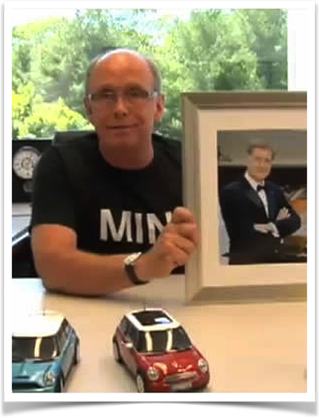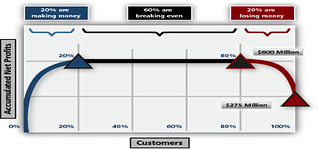Growth Insights for CEOs
The Chief Outsider
Recent Posts

AI Search is Here – And it’s Reshaping the Buyer Journey
Part 1 of our four-part series exploring how AI search is transforming visibility, SEO, and digital strategy - and what CEOs need to do now to stay competitive.
| Executive Takeaways |
| Declining web traffic isn’t random - it’s a symptom of changing search behavior. AI search is already impacting over 25% of user journeys - and growing fast If you’re not being cited, you’re missing opportunities-period. |
Recent Posts

Marketing Requires Vision
Tue, May 6, 2014 — Over the years that I was in marketing leadership, I experienced the variety of misconceptions that companies had with marketing. It was rare to find a company that viewed marketing as a profitable tool to communicate the vision of the company. Instead, they expected marketing to compensate for their shortcomings, and somehow convince customers to prefer us despite our failures.

Who Are the Top Business Consulting Firms in Charlotte, NC?
Wed, Apr 30, 2014 — Top Business Consulting Firms Based in Charlotte, NC There are a wide range of consulting firms and business advisory formats available to CEOs and Presidents in Charlotte, North Carolina. As a marketing consultant, I’ve had the opportunity to work with and observe a range of firms, gaining insight into the strengths of various consulting formats.

80% of CEOs Have Lost Trust in Their Marketers
Wed, Feb 19, 2014 — The following blog is Part II to my recent blog Over 70% of CMOs failed to deliver expected real ROI for their efforts in 2013 The breadth of discontent among companies with their marketing begs a further look at the why? How have CMOs become less well regarded than say their IT peers, who have something in the neighborhood of a 50% success rating for their projects? Why is the role of the CMO oftentimes the most precarious in the c-suite? Why are 80% of CEOs unhappy with their marketing talent? The consensus seems to be skill level. While many marketers are strong in one or two or even more areas across the board, strength in both left and right brain functions is rare. And oftentimes, the lure of a good creative can be seductive to a CEO, but at the expense of solid business acumen, disappointment is a sure thing. Few marketers have the finance, technical or operations knowledge to effectively lead business modeling, strategy, and positioning as well as marketing functions such as operations and technology, so instead focus on the ‘softer’ or more tactical aspects of the role.
Stay up-to-date with the latest from Chief Outsiders

Customers Are Not All Equal
Fri, Feb 14, 2014 — Why it’s important to understand customer value, and what to do about it Every Management Team knows the intricacies of their respective P&L, but can they honestly say they understand the value that each customer delivers to their franchise? More importantly, if they have gone through the hard work of developing a robust customer profitability analysis, have they taken the next step to implementing key business changes based upon the data?(http://www.journalofaccountancy.com/Issues/2008/Dec/ManagingCustomerProfitability.htm) I have worked for some of the leading Fortune 50 companies over my career, where the Leadership Teams actively managed their P&L’s to ensure top and bottom line growth. Not until I was “tapped on the shoulder” to take a senior leadership role in one of our “challenged” businesses, did we even start the discussion about how much each of our customers brought to the bottom line. It was important as we treated every customer the same – meaning, they received superior customer service. Theoretically, we would never consciously bring in unprofitable customers, but the reality was that every customer didn’t bring the same value to the bottom line.

5 Marketing Strategies Community Banks Use to Move Past Competitors
Sun, Dec 22, 2013 — A recent Wall Street Journal article by Francesco Guerrera, Lenders Looking All Too Similar, quoted a tycoon as stating he chose his financial services on price, because “in the end, banks are really all the same”. This is the last thing any of us want to hear about our business, especially if we are in an industry that prides itself on spending a great deal of time developing an understanding of our customers and creating and marketing solutions designed to appeal to their unique needs. Supporting the belief that strategic innovation can make a difference, Bloomberg BusinessWeek’s article Rural Banks Know Something Big Banks Don’t by Brendan Greeley argues that great customer service combined with other good business practices can produce a good return for shareholders.Over the past year I’ve had the opportunity to work with several community banks and credit unions, and have been impressed with how they are able to defy the premise of the WSJ article. Here are 5 marketing strategies on how nimble organizations have been able to understand their customer and move faster and/or smarter than their larger competitors.

David vs. Goliath: How small companies can create marketing that stands up to big brands
Sat, Dec 21, 2013 — Here’s the question: When competing for the hearts and minds of prospects and customers, how do smaller companies effectively compete with the big spending of big brands? Underdogs like me want to know.

Recruit, Hire, Train. Are you better at it than your competitors?
Sun, Dec 15, 2013 — 4 Steps to Help Get You on Track with Employment Branding This blog is written by guest blogger, Kathi Crawford. Word travels fast in our social, interactive, digital world where everyone and everything has a brand vying for attention. No doubt, significant resources and effort are devoted to branding a company’s product or service. However, it is easy to make the business case that branding in the employment marketplace is equally as vital to an organization’s success. Many CEO’s often overlook this business driver.

Center For Creative Leadership: What Happens When You Take Marketing Seriously?
Sat, Dec 14, 2013 — Greensboro N.C.'s Center For Creative Leadership (CCL) was a pioneer in understanding what makes a leader, and in applying this research through executive education. Since their founding in1970, almost 500,000 global leaders have completed a CCL leadership program. As in all industries, success brings both innovation and imitation from existing and new competition.

The Buying Process Has Changed: How Well Has Your Marketing Adapted?
Sun, Dec 8, 2013 —
.png?width=1500&height=398&name=CO_Corporate%20Logo%202021_4C_HOR_FNL-1%20(1).png)